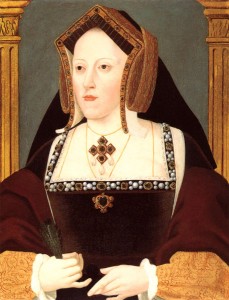By Luz Santodomingo & Samuel Yelton
Catherine of Aragon (Spain, 1485-England, 1536) Born December 16, 1485, she was the daughter of Isabella, Queen of Castile, and Ferdinand II of Aragon.[1] Catherine was the youngest of four daughters. Her sisters were Isabella, Queen of Portugal; Juana, Queen of Castile; and Maria, Queen of Portugal.[2]
Compared to the traditional education of female nobility, Catherine and her sisters were provided with extensive tutoring on the insistence of their mother. Selected for this task was the Papal Nuncio Antonio Geraldini, and following his death in 1489, his brother Alessandro. Both men were proponents of new Humanistic scholarship based on recovered Greek and Roman texts.[3] Their educational program for the royal daughters reflected this, consisting of “the Roman statesman, dramatist, and philosopher Seneca, the Christian poets Prudentius and Juvencus, and great doctors of the Church: Saints Ambrose, Augustine, Jerome, and Gregory…canon and civil law as well as history and Latin.”[4] Catherine developed a close connection with Alessandro, who would serve the princess in England as her personal chaplain.[5]
On November 14, 1501, at the age of fifteen, Catherine was married to Arthur Tudor, Prince of Wales and son of Henry VII, King of England and Lord of Ireland.[6] The marriage lasted only four months and nineteen days, until the death of Prince Arthur on April 2, 1502. Immediately after his death, Catherine was contracted to wed Arthur’s brother Prince Henry, the future Henry VIII. At that time he was only twelve years old. At the age of fourteen he protested against the marriage, but subsequently accepted it, and on June 11, 1509, Prince Henry and Catherine of Aragon were married.[7] They had a joint coronation on June 24 of the same year.[8]
Catherine quickly emerged as a leading figure of the court and took an active role in the management of the nation. Most prominently, in 1513 Catherine served as governor of the realm and captain-general of English army while Henry campaigned on the continent against the French. During that time, she had overall command of the forces that won a devastating victory over the invading forces of Scotland at Flodden Field, securing the northern border in Henry’s absence.[9] Catherine also acted as a patroness of education and scholarship, for instance, supporting Cardinal Thomas Wolsey’s effort in 1524 to found an institution of Humanist learning that would later become Christ Church of Oxford.[10] [11]
Catherine’s role in promoting learning was recognized by the distinguished Humanist, Desiderius Erasmus. In a letter to Paolo Bombache in 1518, Erasmus, praised Henry’s court as “more like an academy than a king’s court,” and described Catherine as “astonishingly well read, far beyond what would be surprising in a woman, and [she is] as admirable for piety as she is for learning.”[12] Catherine served as patron both to Erasmus and the Spanish Humanist scholar Juan Luis Vives.[13] Vives dedicated two of his works to Queen Catherine, De Institutione Feminae Christianae [The Education of a Christian Woman] and De Ratione Studii Puerilis [The Plan of Study for Children], both written in 1523 while he was acting as tutor for Catherine’s daughter, Princess Mary.[14]
Catherine was pregnant six, possibly seven, times, but only Mary, born in 1516, survived to adulthood. The first, third, and sixth pregnancies ended in stillbirths; the second and fourth produced male infants that seemed to be healthy at birth, but died in infancy.[15]
Catherine’s maid of honor, Anne Boleyn, attracted Henry’s attention, which she resisted either from principle or policy.[16] Stimulated by his desire for Anne, as well as for a male heir, King Henry VIII applied to the court of Rome for an annulment of his marriage to Catherine in 1527.[17] Henry claimed that Catherine’s previous marriage to his brother Arthur made their current union a violation of Canon Law, and that the prior approval by the Papacy had been in error. Convinced that this fact made his marriage with Catherine incestuous, Henry alleged that the deaths in infancy of his two healthy sons was punishment by an angry God.[18]
In 1529, a trial began in London in order to annul the marriage, but Catherine insisted that her marriage with Arthur was never consummated.[19] The trial ended inconclusively, with the reigning Pope, Clement VII, attempting to delay final judgement to appease both Henry, and Catherine’s powerful relative, the Holy Roman Emperor Charles V.[20] Henry took such equivocation as an insult, and had his reply to Clement carried by Anne Boleyn’s father, Thomas, who refused to perform the ceremonial act of obedience of kissing Clement’s toe: “Such was the first instance of disrespect manifested by England to the papal dignity [the Pope], which gradually led to a total separation, and laid the foundation for the success of the Reformation.”[21] Furthermore, beginning in 1531 Henry essentially turned Catherine into a prisoner, banning her from his presence and confining her successively to several country estates.[22]
Henry married Anne Boleyn in a private ceremony in January, 1533.[23] The marriage was made public and Anne’s pregnancy announced. The marriage with Catherine was formally annulled at Henry’s behest by the Archbishop of Canterbury, Thomas Cranmer.[24] The Papacy refused to recognize the validity of this action; however, by this time Henry had proclaimed his own authority as head of the Church of England over the Pope in the Act of Supremacy.[25] Catherine spent the last part of her life at Kimbolton Castle in Huntingdonshire. There, she devoted herself to austerity and under her garments wore the habit of St. Francis of Assisi.[26] The King reneged on his initial commitment to Catherine, and removed Mary from the succession to the throne.
Catherine died three years later, on January 7, 1536.[27]
[1] Helena Bergmann, “Catherine of Aragon,” Mary Hays, Female Biography; or, Memoirs of Illustrious and Celebrated Women, of All Ages and Countries (1803) Chawton House Library Series: Women’s Memoirs, ed. Gina Luria Walker, Memoirs of Women Writers Part II (Pickering & Chatto: London, 2013), vol. 6, 153-69, editorial notes, 423-24, on 423.
[2] Bergmann, “Catherine of Aragon,” vol. 6, 153-69, editorial notes, 423-24, on 423.
[3] Key to Umbria. “Amelia: Geraldini Family.” Accessed April 27, 2015. http://www.keytoumbria.com/Amelia/Geraldini_Family.html
[4] Julia P. Geraldi, In Triumph’s Wake: Royal Mothers, Tragic Daughters, and the Price They Paid for Glory (New York: St. Martin’s Press, 2008), 61.
[5] Key to Umbria. “Geraldini Family.”
[6] Bergmann, “Catherine of Aragon,” vol. 6, 153-69, editorial notes, 423-24, on 423.
[7] Bergmann, “Catherine of Aragon,” vol. 6, 153-69, editorial notes, 423-24, on 423.
[8] Bergmann, “Catherine of Aragon,” vol. 6, 153-69, editorial notes, 423-24, on 423.
[9] Mortimer Levine, “The Place of Women in Tudor Government,” in Tudor Rule and Revolution, ed. DeLloyd J. Guth and John W. McKenna. (Cambridge: Cambridge University Press, 1982), 116.
[10]Catherine F. Gunderson, “Catherine of Aragon,” in Contemporaries of Erasmus: A Biographical Registrar of the Renaissance and Reformation, Vol. 1-3, ed. Peter G. Bietenholz and Thomas Brian Deutscher. (Toronto: University of Toronto Press, 1985), 283.
[11]Christ Church Oxford. “The History of Christ Church.” Accessed April 27, 2015. http://www.chch.ox.ac.uk/visiting/history
[12] R.A.B Mynors and D.F.S Thomson, trans., The Correspondence of Erasmus, Vol. 6 (University of Toronto Press, 1982), 63.
[13] Mary Hays, “Catherine of Aragon,” Female Biography; or, Memoirs of Illustrious and Celebrated Women, of all Ages and Countries (6 volumes) (London: R. Phillips, 1803), vol. 2, 151-69, on 152,and Bergmann, “Catherine of Aragon,” vol. 6, 153-69, editorial notes, 423-24, on 423.
[14] Hays, “Catherine of Aragon,” vol. 2, 151-69, on 152, and Bergmann, “Catherine of Aragon,” vol. 6, 153-69, editorial notes, 423-24, on 423.
[15] H. Eugene Lehman, Lives of England’s Reigning and Consort Queens (United States of America: AuthorHouse, 2011), 288.
[16] Mary Hays, “Anne Boleyn,” Female Biography; or, Memoirs of Illustrious and Celebrated Women, of all Ages and Countries (6 volumes) (London: R. Phillips, 1803), vol. 2, 9-26, on 10.
[17] Philippa Gregory, “Anne Boleyn,” Mary Hays, Female Biography; or, Memoirs of Illustrious and Celebrated Women, of All Ages and Countries (1803). Chawton House Library Series: Women’s Memoirs, ed. Gina Luria Walker, Memoirs of Women Writers Part II (Pickering & Chatto: London, 2013), vol. 6, 11-28, editorial notes, 408-10, on 408.
[18] Gregory, “Anne Boleyn,” vol. 6, 11-28, editorial notes, 408-10, on 408.
[19] Patrick Williams, Katherine of Aragon: Henry VIII’s lawful wife? (Great Britain: Amberley, 2013), 284-6.
[20]Hays, “Catherine of Aragon,” vol. 2, 151-69, on 163.
[21] Hays, “Catherine of Aragon,” vol. 2, 151-69, on 163.
[22]Gunderson, “Catherine of Aragon,” 284.
[23] Williams, Katherine of Aragon: Henry VIII’s lawful wife?, 338.
[24] Giles Tremlett. Catherine of Aragon: Henry’s Spanish Queen (London: Faber and Faber Ltd, 2011), 353.
[25]Gunderson, “Catherine of Aragon,” 284.
[26] Hays, “Catherine of Aragon,” vol. 2, 151-69, on 167.
[27] Bergmann, “Catherine of Aragon,” vol. 6, 153-69, editorial notes, 423-24, on 424.
Bibliography
Bergmann, Helena. “Catherine of Aragon.” Mary Hays, Female Biography; or, Memoirs of Illustrious and Celebrated Women, of All Ages and Countries (1803) Chawton House Library Series: Women’s Memoirs, ed. Gina Luria Walker, Memoirs of Women Writers Part II. Pickering & Chatto: London, 2013, vol. 6, 153-69, editorial notes, 423-24.
Gregory, Philippa. “Anne Boleyn.” Mary Hays, Female Biography; or, Memoirs of Illustrious and Celebrated Women, of All Ages and Countries (1803). Chawton House Library Series: Women’s Memoirs, ed. Gina Luria Walker, Memoirs of Women Writers Part II. Pickering & Chatto: London, 2013, vol. 6, 11-28, editorial notes, 408-10.
Hays, Mary. “Catherine of Aragon.” Female Biography; or Memoirs of Illustrious and Celebrated Women of all Ages and Countries (6 volumes). London: R. Phillips, 1803, vol. 2, 151-69.
Lehman, H. Eugene. Lives of England’s Reigning and Consort Queens. United States of America: AuthorHouse, 2011.
Tremlett, Giles. Catherine of Aragon: Henry’s Spanish Queen. London: Faber and Faber Ltd, 2011.
Williams, Patrick. Katherine of Aragon: Henry VIII’s lawful wife? Great Britain: Amberley, 2013.
Resources:
Brooklyn Museum
Elizabeth A. Sackler Center for Feminist Art: The Dinner Party: Heritage Floor: Catherine of Aragon
http://www.brooklynmuseum.org/eascfa/dinner_party/heritage_floor/catherine_of_aragon.php
Page Citation:
Luz Santodomingo & Samuel Yelton. “Catherine of Aragon.” Project Continua (July 9, 2015): Ver. 1, [date accessed], http://www.projectcontinua.org/catherine-of-aragon/
Tags: End of Renaissance, Europe, Queens, Reformation, Renaissance
